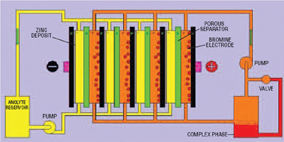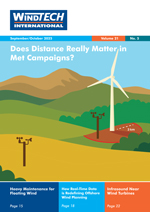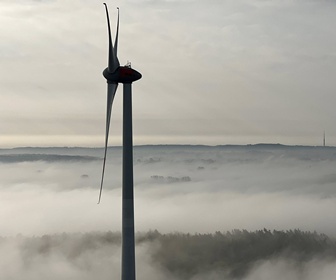- Category: Articles
Rotor Inertia, Ultracapacitors and Batteries for Wind Power Smoothing
 The US wind power industry experienced growth of 45% in 2007, with over 5,200MW installed. According to a new technical report published by the US Department of Energy, the installed wind energy capacity could reach 300GW to meet 20% of the US electricity demand by the year 2030. However, the availability of wind energy is estimated at around 15 to 30%. To avoid frequency and voltage drifts due to short-term wind variations, and to lower the need for spinning reserves due to the intermittent nature of the wind in a system with higher wind energy penetration, different techniques may be utilised. Some tools that can be employed are rotor inertia, in variable speed wind turbines, and ultracapacitors for short-term and battery energy storage for long-term, power levelling.
The US wind power industry experienced growth of 45% in 2007, with over 5,200MW installed. According to a new technical report published by the US Department of Energy, the installed wind energy capacity could reach 300GW to meet 20% of the US electricity demand by the year 2030. However, the availability of wind energy is estimated at around 15 to 30%. To avoid frequency and voltage drifts due to short-term wind variations, and to lower the need for spinning reserves due to the intermittent nature of the wind in a system with higher wind energy penetration, different techniques may be utilised. Some tools that can be employed are rotor inertia, in variable speed wind turbines, and ultracapacitors for short-term and battery energy storage for long-term, power levelling.By Adel Nasiri, Assistant Professor, Power Electronics and Electric Motor Drives Laboratory, University of Wisconsin-Milwaukee, USA .
- Category: Articles
A Vertical Access Wind Turbine for the Built Environment
 A recent report from the British Wind Energy Association on the small wind industry in the UK identified an annual growth rate of about 80%, and suggested that this was set to continue at a similar rate for the foreseeable future. However, despite the evidently huge market potential, some critics are still saying that much of the technology is not suited to the built environment and that the available equipment is generally expensive, with long payback times. It is easy to understand these views when you see a typical horizontal axis wind turbine (HAWT) sited in an urban setting, continually hunting for the wind on a blustery day, and when the cost of one of the helical type vertical axis wind turbines (VAWTs) is £25,000 before installation costs of a further £10,000-15,000. However, a newly developed VAWT, designed to meet this demand and costing about? £12,000 fully installed and connected, is to go onto the market shortly.
A recent report from the British Wind Energy Association on the small wind industry in the UK identified an annual growth rate of about 80%, and suggested that this was set to continue at a similar rate for the foreseeable future. However, despite the evidently huge market potential, some critics are still saying that much of the technology is not suited to the built environment and that the available equipment is generally expensive, with long payback times. It is easy to understand these views when you see a typical horizontal axis wind turbine (HAWT) sited in an urban setting, continually hunting for the wind on a blustery day, and when the cost of one of the helical type vertical axis wind turbines (VAWTs) is £25,000 before installation costs of a further £10,000-15,000. However, a newly developed VAWT, designed to meet this demand and costing about? £12,000 fully installed and connected, is to go onto the market shortly.- Category: Articles
A Numerical Study to Verify the Effects
 The sensors for yaw control are usually located on top of the nacelle of horizontal axis wind turbines (HAWTs). However, because of the different relative positions of the rotor and the tower in upwind and downwind HAWTs, the position of the nacelle yaw sensors will also be reversed. Research has been carried out to quantify the effect that different factors have on the efficient running of the turbines in complex terrains and the results are presented in the following article.
The sensors for yaw control are usually located on top of the nacelle of horizontal axis wind turbines (HAWTs). However, because of the different relative positions of the rotor and the tower in upwind and downwind HAWTs, the position of the nacelle yaw sensors will also be reversed. Research has been carried out to quantify the effect that different factors have on the efficient running of the turbines in complex terrains and the results are presented in the following article.- Category: Articles
The PowerModule PM3000W
 The rising demand and increasing penetration of wind-generated electricity has created a critical need for power conversion systems designed to meet the unique requirements of the wind power market. This article describes the benefits of American Superconductor's PowerModule PM3000W, a fully programmable, flexible and modular power converter developed specifically for wind power applications.
The rising demand and increasing penetration of wind-generated electricity has created a critical need for power conversion systems designed to meet the unique requirements of the wind power market. This article describes the benefits of American Superconductor's PowerModule PM3000W, a fully programmable, flexible and modular power converter developed specifically for wind power applications.- Category: Articles
The Wind Power of Tomorrow on Your Screen Today
 Either for trading or for power system operation, wind power forecasts have become necessary input to the daily management of wind generation. While fast transfer of research results to operational and commercially available products has been witnessed over the last few years, there are still challenges to face in order for wind power forecasts to fully satisfy the needs of their various users.
Either for trading or for power system operation, wind power forecasts have become necessary input to the daily management of wind generation. While fast transfer of research results to operational and commercially available products has been witnessed over the last few years, there are still challenges to face in order for wind power forecasts to fully satisfy the needs of their various users.By Pierre Pinson, , Gregor Giebel and Henrik Madsen, Technical University of Denmark, Denmark .
- Category: Articles
ZephIR Minimises Risk for NaiKun's Offshore Wind Farm Development
 ZephIR has now been used as the sole on-site resource assessment tool for the Hecate Strait wind farm project for 12 months. This article reflects on the pioneering approach taken by NaiKun Wind Development Inc and the results delivered by ZephIR to date.
ZephIR has now been used as the sole on-site resource assessment tool for the Hecate Strait wind farm project for 12 months. This article reflects on the pioneering approach taken by NaiKun Wind Development Inc and the results delivered by ZephIR to date.- Category: Articles
Endurance Calculations for Bearings
 Practical experience has shown that seemingly identical rolling bearings operating under identical conditions will not necessarily exhibit the same endurance life. Standardised life calculation methods can help us make educated choices about a bearing size's suitability for a particular application.
Practical experience has shown that seemingly identical rolling bearings operating under identical conditions will not necessarily exhibit the same endurance life. Standardised life calculation methods can help us make educated choices about a bearing size's suitability for a particular application.Use of cookies
Windtech International wants to make your visit to our website as pleasant as possible. That is why we place cookies on your computer that remember your preferences. With anonymous information about your site use you also help us to improve the website. Of course we will ask for your permission first. Click Accept to use all functions of the Windtech International website.










